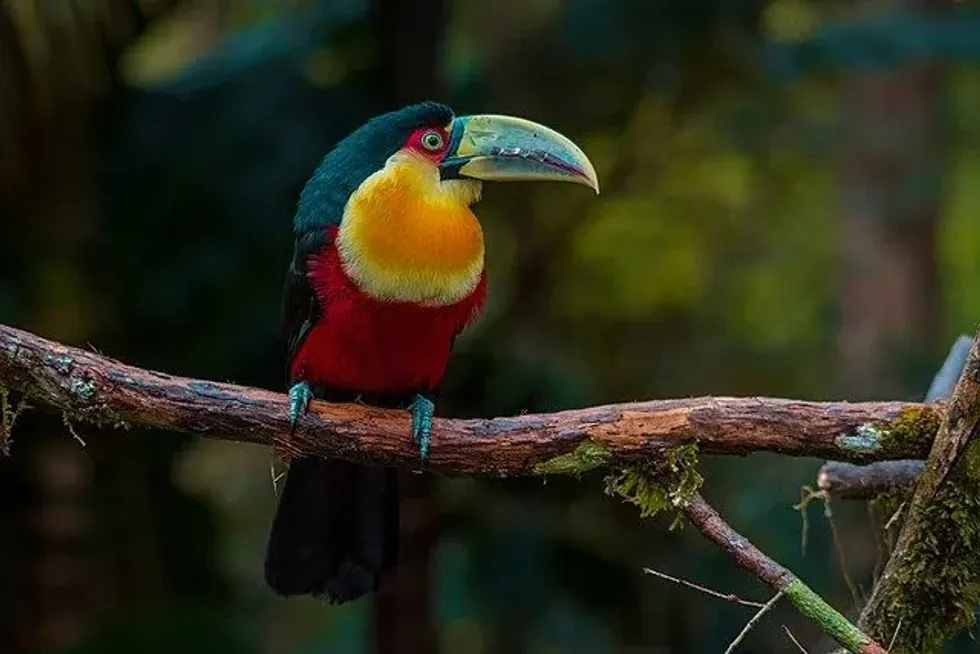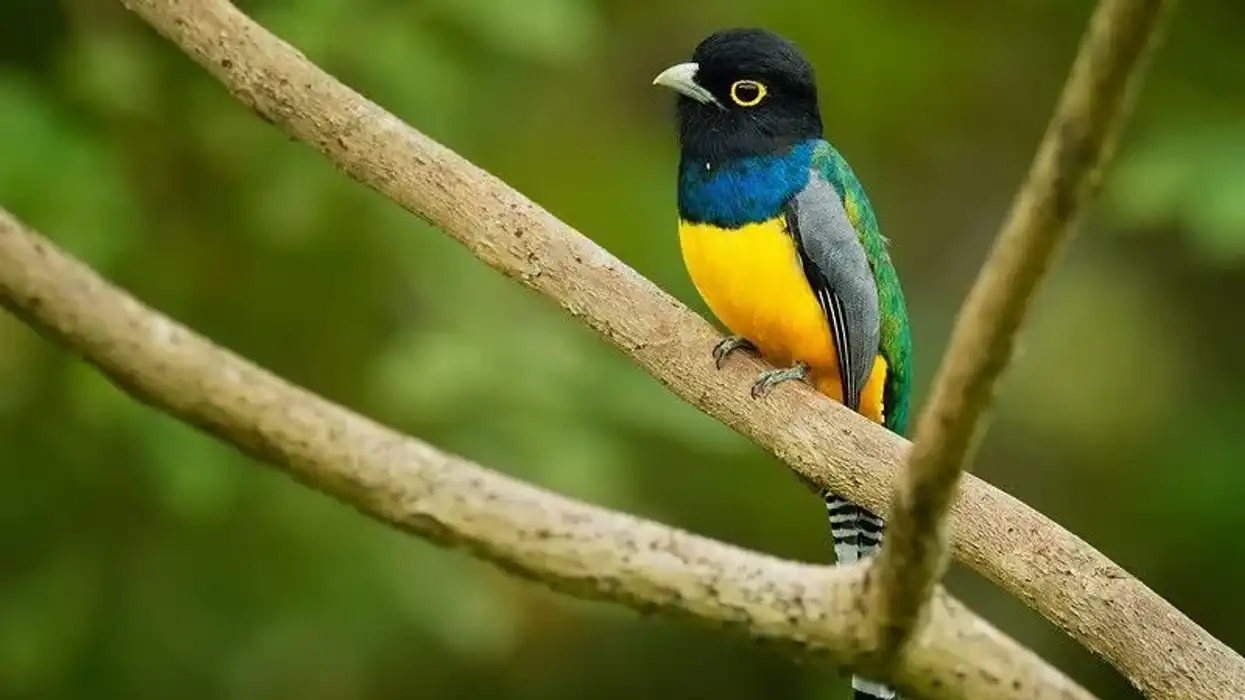If you are interested in learning about different species of toucans, then you should definitely go through this article on green-billed toucans. The green-billed toucan (Ramphastos dicolorus) is closely related to the keel-billed toucan (Ramphastos sulfuratus).
Green-billed toucans inhabit tropical and subtropical forests. They are quite widespread in parts of South America. Spotting green-billed toucans sitting on a tree or in flight is a common situation throughout its distribution range.
The diet of the green-billed toucans is mostly fruit-based. However, they also prey on certain insects and smaller birds, along with the fruit. They are quite social species and are mostly seen in flocks or pairs.
A flock of green-billed toucans can consist of 20 or more birds. The green-billed toucan is also popularly known as a red-breasted toucan due to the presence of red color in its belly.
For more relatable content, check out these green heron facts and palm cockatoo facts for kids.
Green-Billed Toucan Interesting Facts
What type of animal is a green-billed toucan?
The green-billed toucan is a type of bird that belongs to the family of Ramphastidae. It is quite widespread in its habitat range.
What class of animal does a green-billed toucan belong to?
The green-billed toucan belongs to the Aves class of Animalia kingdom. It is a member of the phylum Chordata and the order Piciformes. The genus of this bird is Ramphastos and the scientific name is Ramphastos dicolorus.
How many green-billed toucans are there in the world?
The exact number of green-billed toucans or red-breasted toucans living in this world is not yet known. According to the International Union for Conservation of Nature or the IUCN, the population trend of this toucan is known to be decreasing.
However, they are very commonly sighted in their distribution range. So, it can be concluded that there is no immediate threat to the bird's population.
Where does a green-billed toucan live?
The green-billed toucan is a bird that is commonly found in parts of South America. A huge number of these toucans inhabits the Atlantic Forest.
Southern and eastern Brazil is home to many of these birds. A green-billed toucan is a common sight in Paraguay and far north-eastern Argentina. Apart from that, certain areas of Bolivia are also home to these species.
What is a green-billed toucan's habitat?
The natural habitat of the green-billed toucan is mainly forest-dependent. It prefers living in tropical and subtropical forests. It is generally found living and flying at a height of 328-4921 ft (100-1500 m). Apart from forests, a green-billed toucan can be found in savanna and areas with a lot of plantations.
Who do green-billed toucans live with?
Like keel-billed toucan (Ramphastos sulfuratus), the green-billed toucan is a social bird. It is known to forage in pairs and flocks. Spotting a flock of 20 or more green-billed toucans is not an uncommon event. Immature chicks live with their parents till they are able to take care of themselves.
How long does a green-billed toucan live?
A green-billed toucan or red-breasted toucan is known to live a long life. The average life expectancy of this bird is 20 years. A toucan of this species is known to live for an average of 16 years and 8 months in captivity.
How do they reproduce?
The breeding season of this species of toucan starts from October and goes on till February. In the northern parts of the green-billed toucan range map, the breeding season is generally from January to June.
The pairs make nests in the existing holes in a tree or tree cavities. They tend to become aggressive during the breeding season and are very particular about their territory. The male tries to attract the female by singing and even throwing fruit at the female.
The clutch consists of about 2-4 eggs. The male and the female take turns to incubate the eggs.
After about two and a half weeks, the eggs hatch. The bill is not so prominent in newborn chicks. It takes about four weeks since hatching for the feathers to expand.
The parents, especially the female take care of feeding the young ones. The chicks stay under the care of both the parents till about eight weeks.
What is their conservation status?
The International Union for Conservation of Nature or the IUCN has listed the green-billed toucan (Ramphastos dicolorus) as Least Concern in their Red List of Threatened Species. Even though the population trend is decreasing, they are still quite widespread.
Moreover, no recovery plans are in action to save the population of this bird. Therefore, it is evident that the population of the green-billed toucan is not facing any risks as of now.
Green-Billed Toucan Fun Facts
What do green-billed toucans look like?
A green-billed toucan is a small toucan with a comparatively small bill. The bill has a light green color and thus the name. The upper part of the toucan's body is cover in glossy black plumage.
The toucan's belly is covered in red feathers. The presence of these red feathers gained them the name red-breasted toucan. The underparts, or the chest, of the toucan are covered in an orangish-yellow plumage and yellow and white sides.
How cute are they?
Even though the bill might look intimidating to some people, the glossy colorful plumage makes the toucans look extremely cute, just like toco toucan.
How do they communicate?
Green-billed toucans communicate through high-pitched calls. The most common call used by them is a continuous 'grrekk'.
How big is a green-billed toucan?
The average body length of a green-billed toucan is known to range from 16.5-18.9 in or 42–48 cm. When compared to most other toucans, they have a smaller beak. The size of the beak is around 3.9 in or 10 cm. They are much shorter than a blue-and-yellow macaw.
How fast can a green-billed toucan fly?
Toucans, in general, can fly at a speed of up to 40 mph (64 kmph). However, the exact speed of this species of toucan is not studied.
How much does a green-billed toucan weigh?
Green-billed toucans weigh around 9.3-14.1 oz (265–400 g).
What are the male and female names of the species?
A male bird is generally referred to as a 'cock' and a female bird is referred to as a 'hen'. So, a male green-billed toucan and a female green-billed toucan will be referred to as the same.
What would you call a baby green-billed toucan?
A baby green-billed toucan is called a chick, just like babies of all other birds.
What do they eat?
Like macaws, the green-billed toucan follows an omnivorous diet. A huge portion of this toucan's diet consists of various fruits and nuts. Apart from that, birds of this species feed on a variety of insects.
Occasionally, smaller birds of other species are preyed on by the green-billed toucan. In captivity, the diet of this toucan is mostly fruit-based. They consume fruits like apples, berries, raspberries, and more.
Are they dangerous?
Unlike hawks, the green-billed toucans are harmless birds. They are not known to pose any threat to humans. The green bill might look scary, but the bill is not strong enough to cause any serious harm.
Would they make a good pet?
A green-billed toucan or a red-breasted toucan is a common pet. The prominent coloration of its feathers and the green bill make it an attractive choice for pets. However, looking after a toucan needs a lot of work and experience. So, the green-billed toucan is not the ideal choice for an inexperienced owner.
Did you know...
A green-billed toucan or a red-breasted toucan is very commonly found in zoos.
The bill of green-billed toucan (Ramphastos sulfuratus) is not capable of digging holes in a tree.
What is the rarest toucan?
The yellow-eared toucanet belonging to the family Ramphastidae, the same family as the green-billed toucan, is the rarest toucan.
How did toucans get their name?
The word 'toucans' is believed to mean 'birds'. Moreover, 'toucan' sounds very similar to the calls of the toucan birds.
Here at Kidadl, we have carefully created lots of interesting family-friendly animal facts for everyone to discover! For more relatable content, check out these umbrellabird facts and bee-eater facts pages.
You can even occupy yourself at home by coloring in one of our free printable green-billed toucan coloring pages.









